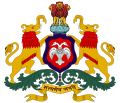
Back Kannada Afrikaans ካነዳኛ Amharic Idioma canarés AN कन्नड़ ANP اللغة الكنادية Arabic الكناديه ARZ কন্নড় ভাষা Assamese Idioma canarés AST Kannada dili Azerbaijani کنادا دیلی AZB
| Kannada | |
|---|---|
| ಕನ್ನಡ | |
 The word "Kannada" in Kannada script | |
| Pronunciation | [ˈkənːəɖa] |
| Native to | India |
| Region | Karnataka |
| Ethnicity | Kannadigas |
| Speakers | L1: 54 million (2021)[1] L2: 25 million (2021) |
Dravidian
| |
Early form | |
| Dialects | |
| Official status | |
Official language in | India
|
| Regulated by | Government of Karnataka[2] |
| Language codes | |
| ISO 639-1 | kn |
| ISO 639-2 | kan |
| ISO 639-3 | kan |
| Glottolog | nucl1305 |
| Linguasphere | 49-EBA-a |
 Distribution of Kannada native speakers, majority regions in dark blue and minority regions in light blue.[3] | |
| Part of a series on the |
| Culture of Karnataka |
|---|
 |
| Person | Kannaḍiga |
|---|---|
| People | Kannaḍigaru |
| Language | Kannaḍa |
Kannada (IPA: [ˈkənːəɖa])[4] is a Dravidian language spoken predominantly in the state of Karnataka in southwestern India, and spoken by a minority of the population in all neighbouring states. It has 44 million native speakers, and is additionally a second or third language for 15 million speakers in Karnataka.[1] It is the official and administrative language of Karnataka.[5] It also has scheduled status in India and has been included among the country's designated classical languages.[6][7]
Kannada was the court language of a number of dynasties and empires of South India, Central India and the Deccan Plateau, namely the Kadamba dynasty, Western Ganga dynasty, Nolamba dynasty, Chalukya dynasty, Rashtrakutas,[8] Western Chalukya Empire, Seuna dynasty, kingdom of Mysore,[9] Nayakas of Keladi,[10] Hoysala dynasty and the Vijayanagara Empire.
The Kannada language is written using the Kannada script, which evolved from the 5th-century Kadamba script. Kannada is attested epigraphically for about one and a half millennia and literary Old Kannada flourished during the 9th-century Rashtrakuta Empire.[11][12] Kannada has an unbroken literary history of around 1200 years.[13] Kannada literature has been presented with eight Jnanapith awards, the most for any Dravidian language and the second highest for any Indian language,[14][15][16] and one International Booker Prize.[17] In July 2011, a center for the study of classical Kannada was established as part of the Central Institute of Indian Languages in Mysore to facilitate research related to the language.[18]
- ^ a b Kannada at Ethnologue (27th ed., 2024)

- ^ The Karnataka official language act, 1963 – Karnataka Gazette (Extraordinary) Part IV-2A. Government of Karnataka. 1963. p. 33.
- ^ Schwartzberg, Joseph E. (1978). "Currency of Selected Languages and Scripts". A Historical Atlas of South Asia. University of Chicago Press. p. 102. ISBN 978-0195068696.
- ^ Reeve, William (1858). Sanderson, Daniel (ed.). A Dictionary, Canarese and English. Bangalore: Wesleyan Mission Press. Retrieved 18 January 2017.
- ^ "The Karnataka Official Language Act" (PDF). Official website of Department of Parliamentary Affairs and Legislation. Government of Karnataka. Retrieved 29 June 2007.
- ^ Kuiper (2011), p. 74
- ^ R Zydenbos in Cushman S, Cavanagh C, Ramazani J, Rouzer P, The Princeton Encyclopedia of Poetry and Poetics: Fourth Edition, p. 767, Princeton University Press, 2012, ISBN 978-0-691-15491-6
- ^ Seshan, Radhika; Kumbhojkar, Shraddha (27 June 2018). Re-searching Transitions in Indian History. Taylor & Francis. ISBN 978-0-429-94630-1.
- ^ Ramaswamy, Harish (2007). Karnataka Government and Politics. Concept Publishing Company. p. 334. ISBN 978-81-8069-397-7.
- ^ Masica, Colin P. (9 September 1993). The Indo-Aryan Languages. Cambridge University Press. ISBN 9780521299442.
- ^ "Rastrakutas". Official website of the Central Institute of Indian Languages. Archived from the original on 10 January 2011. Retrieved 12 May 2008.
- ^ Zvelebil (1973), p. 7 (Introductory, chart)
- ^ Garg (1992), p. 67
- ^ "Jnanpeeth Awardees from Karnataka | Jnanapeeta Awardees | Jnanpith Award". www.karnatakavision.com. Archived from the original on 11 February 2021. Retrieved 5 July 2018.
- ^ "Jnanpith Award: Eight Kannada authors who have won 'Jnanpith Award'". 5 September 2017. Archived from the original on 22 December 2020. Retrieved 5 July 2018.
- ^ "Jnanpith Awards Winners Full List". 27 July 2016.
- ^ Mollan, Cherylann (21 May 2025). "Heart Lamp: Banu Mushtaq makes history with International Booker Prize win". BBC. Retrieved 21 May 2025.
- ^ "IBNLive – CIIL to head Centre for classical Kannada study". ibnlive.in.com. 23 July 2011. Archived from the original on 11 January 2012. Retrieved 12 February 2013.
© MMXXIII Rich X Search. We shall prevail. All rights reserved. Rich X Search